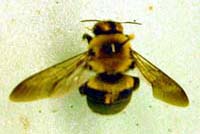Identification Characteristics
- 3/4 -1 inch in length
- Coloration: Metallic blue-black with green or purplish reflections
- Covered with orange or bright yellow hairs.
- Resemble bumblebees in size and coloration except for the top of the abdomen which is black and largely devoid of hair.
- Females have a dense brush of hairs on their hind legs
Damage

Wood Destroying Insects
For their nesting sites carpenter bees prefer softwoods such as redwood, cypress, cedar, and pine. Occasionally hardwoods occasionally are used for nesting sites, but only after being softened by exposure or decay. Any damage to a structure is usually only slight and amounts to only cosmetic defacement. Serious damage can occur when old galleries are expanded or new ones are constructed in the same piece of wood. Abandoned nest can be inhabited by wasps, ants, other bees and scavengers such as Dermestid beetles.
Entrance is clean cut 1/2 – 1 inch deep and approximately 1/2 inch wide. After this the female turns at right angles and burrows with the grain of the wood as for as much as 6 to 8 inches in either direction. Cells are in a linear series of 6 to 9 cells. Each cell contains a food mass for the hatching larva.